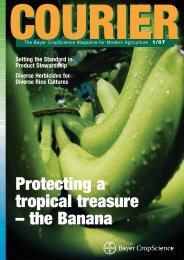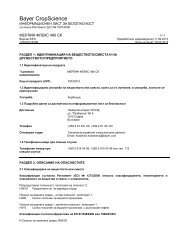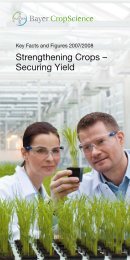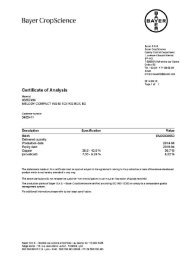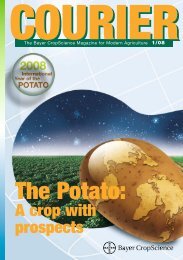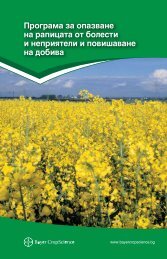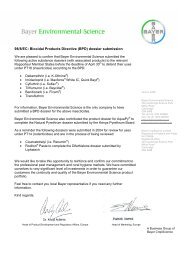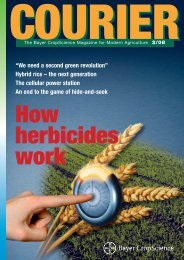For healthy potatoes - Bayer CropScience
For healthy potatoes - Bayer CropScience
For healthy potatoes - Bayer CropScience
You also want an ePaper? Increase the reach of your titles
YUMPU automatically turns print PDFs into web optimized ePapers that Google loves.
InVigor ® Hybrid Canola:<br />
Where Vision plus expertise<br />
breeds success<br />
Hybrids are not just the fruit of expertise. In the case of canola, the creation of<br />
<strong>Bayer</strong> <strong>CropScience</strong>’s hybrid business also required vision. Over the last 10 years,<br />
<strong>Bayer</strong> <strong>CropScience</strong> built up “from scratch” what has become the number one<br />
hybrid canola business in Canada with over 30% of planted canola acres. The<br />
experts imagined, designed and delivered the SeedLink hybridization system.<br />
SeedLink is a completely stable pollination control system that was the first of<br />
its kind. Out in the field, SeedLink is combined with LibertyLink ® herbicide<br />
tolerance.<br />
They then built up a world class breeding program and set new heights<br />
for performance in the field. They also work within a globally<br />
evolving regulatory framework<br />
to obtain commercial<br />
Cross-pollination<br />
approvals. Today, third party<br />
national field trials show that<br />
InVigor ® canola varieties are<br />
on top of the pile in terms<br />
of yield performance.<br />
SeedLink<br />
male<br />
From breeding to productivity:<br />
The corn example<br />
Hybrids are one of the main contributing<br />
factors to the dramatic rise in agricultural<br />
output during the last half of the 20th century.<br />
While “productivity” is a term that<br />
connotes superfluous production in many<br />
developed countries, for less privileged<br />
regions of the world, further improvements<br />
in productivity will be vital for their survival.<br />
Modern corn hybrids substantially outyield<br />
conventional cultivars and tend to<br />
respond better to fertilization, which<br />
makes them attractive to farmers worldwide.<br />
In the US, hybrid corn, which was<br />
first introduced in significant amounts in<br />
1932, now makes up about 95 per cent of<br />
total harvests. Indeed, today, nearly all the<br />
field corn grown in the United States and<br />
most other developed nations is hybrid corn.<br />
SeedLink<br />
female<br />
SeedLink<br />
hybrid<br />
The next hybrid revolution:<br />
Hybrid Rice<br />
Expected Rice Demand in selected Countries<br />
2000/2025 in M Tons (source FAO)<br />
300<br />
250<br />
200<br />
150<br />
100<br />
50<br />
China<br />
India<br />
Indonesia<br />
Bangladesh<br />
Vietnam<br />
Brazil<br />
Thailand<br />
0<br />
214<br />
264<br />
106<br />
145<br />
49<br />
64<br />
32<br />
44<br />
20<br />
26<br />
12<br />
16<br />
12<br />
15<br />
2000<br />
2025<br />
10<br />
14<br />
Philipines<br />
Rice is the most important cereal grown<br />
globally and the major staple food for<br />
about half of the world population. Within<br />
the next 20 years, the global production of<br />
rice needs to increase by 20 to 30% to satisfy<br />
the demand of an expanding worldwide<br />
population. Due to urban and industrial<br />
development, this increase must be<br />
achieved in the face of declining arable<br />
land and water supplies. In this context,<br />
improving yields has become an issue of<br />
utmost importance and is the main challenge<br />
for the rice community.<br />
Hybrid rice is expected to play a major<br />
role in breaking the current yield frontier,<br />
thereby contributing to sustainable food<br />
security. In the context of an increasingly<br />
competitive environment, the higher productivity<br />
of hybrid rice will also contribute<br />
to improving the profitability and competitiveness<br />
of rice cultivation.<br />
In breeding, the use of hybrid vigor in<br />
first-generation seeds is well known. However,<br />
until about 30 years ago, its application<br />
in rice was limited because of the selfpollinating<br />
character of that crop. In 1974,<br />
Chinese scientists successfully transferred<br />
the male sterility gene from wild rice to<br />
create the cytoplasmic genetic male-sterile<br />
(CMS) line and hybrid combination. 4<br />
The first generation of hybrid rice varieties<br />
produced yields that were about 15 to<br />
20 percent greater than those of improved<br />
or high-yielding varieties of the same<br />
growth duration. The most recent hybrids<br />
now provide even higher yield benefits.<br />
Hybrid rice seed enables farmers to<br />
achieve significant yield improvements<br />
over open pollinated or “inbred” varieties.<br />
Rice hybrids combine the positive qualities<br />
of both parents and have the potential to<br />
yield 15 to 35% more than the best inbred<br />
variety grown in similar conditions.<br />
Hybrid rice has also proven to be hardier in<br />
adverse growing conditions, especially in<br />
unfavorable soil and climatic conditions –<br />
such as saline soils and uplands.<br />
As with other hybrids, the production of<br />
hybrid rice seeds requires considerable<br />
manpower and inputs, which explains why<br />
hybrid seed tends to be more expensive<br />
than inbred seed. However, hybrid rice cultivation<br />
requires less seed per hectare than<br />
inbred lines. All in all, the higher seed<br />
price per kg is more than offset by lower<br />
seed planting density requirements and<br />
higher yields, making hybrid rice cultivation<br />
very profitable for farmers.<br />
4) In rice crops there are two systems for producing<br />
hybrids referred to as 3-line and 2-line systems. The<br />
most common is called CMS – or the 3-line system –<br />
invented in China in the 70s and based on the transfer<br />
by breeding of a naturally occurring “male sterility”<br />
gene from wild rice to cultivated rice in order to create<br />
a cytoplasmic male sterile (CMS) female line. The<br />
2-line system referred to as environmentally genetic<br />
male sterile (EGMS) involves a female parent which is<br />
an EGMS female line (male sterility induced by thermo<br />
sensitivity or photosensitivity).<br />
18 COURIER 2/06





